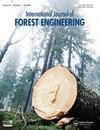Introduction for special issue “COFE-FORMEC 2021 joint meeting”
IF 2.1
3区 农林科学
Q2 FORESTRY
引用次数: 0
Abstract
Oregon State University hosted the 43rd annual meeting of the Council on Forest Engineering (COFE) and the 53rd annual meeting of the International Symposium on Forest Mechanization (FORMEC) jointly as a virtual meeting during September 27–30, 2021. This event was the second of the three consecutive annual joint meetings scheduled between COFE and FORMEC. The event theme was “Forest Engineering Family – Growing Forward from Our Roots.” A total of 225 attendees from five regions participated including Africa (8), Asia/Oceania (22), Europe (105), North America (73), and Central/South America (17). Thirty-four of the participants were graduate students. There were six Keynote addresses: Digital Learning as an Opportunity for Forestry Qualification as a European Task (Lea Schmeil, Andrea Teutenberg), How will COVID-19 Change Forestry Education? A Case Study of US Forest Operations Instructors (Elizabeth Dodson, Charles Blinn), The Economic Potential for Tele-extraction of Roundwood in Sweden (Mikael Lundbäck, Dag Fjeld, Carola Häggström, Tomas Nordfjell), Assistance System for an Automatic Loading Process (Chris Geiger, Michael Weissenboeck, Marcus Geimer), The Role of Forest Engineering in Curbing Climate Change (Rene Zamora Cristales) and Integrating Forest Biomass into Regional-scale Multifeedstock Supply Chain Models (Nathaniel Anderson, Matt Thompson, Jingxin Wang, Damon Hartle). The program was centered around 11 themes: Human Factors and Safety (14 presenters), Education, Training and Workforce Development (6 presenters), Inventory, Remote Sensing and Precision Technology (16 presenters), Supply Chain and Logging Industry (7 presenters), Harvesting and Processing (19 presenters), Steep Slope Harvesting (11 presenters), Harvest Operations Planning (6 presenters), Forest Roads (6 presenters), Log Transportation (8 presenters), Environmental Impacts (9 presenters), and Forest Biomass and Bioenergy (16 presenters). In addition, 25 posters were presented along with 17 student flash talks. Of the 118 presentations, 10 submitted papers were peerreviewed and accepted for publication in this special issue. The papers span a wide array of topics and geographic locations covering 7 of the 11 program themes. Under Human Factors and Safety, Lyons et al. focus on developing computer simulations for risk assessment by cable logging rigging crews. Under Remote Sensing and Precision Technology, Schmiedel et al. examine stand-specific working methods for harvester operators. Under Supply Chain and Logging Industry, Gercans et al. discuss business success factors for Latvian and Swedish forestry contractors. Under Harvesting and Processing, Lundbäck et al. look at the economic potential of semi-automated teleextraction of roundwood in Sweden, Bergstrom et al. examine the effects of boom-corridor thinning on harvester productivity and residual stand structure, and Rocha et al. look at the economic viability of whole tree harvesting under conditions of uncertainty. Under Steep Terrain, Bont et al. compare empirical measurements of tensile forces and deflections on skylines with close-to-catenary predictions and Sessions and Wimer present a mobility model for a tethered skidder. Under Forest Roads, Starke and Aebischer present machine vision-based water-logged area detection for gravel road condition monitoring, and under Forest Biomass and Bioenergy, Garren et al. evaluate the productivity and costs of five energywood harvesting operations in the lower Mid-Atlantic Region of the USA. COFE and FORMEC are pleased to collaborate with the International Journal of Forest Engineering to publish this special issue. We are especially grateful to the authors who submitted their work for consideration, to the reviewers who committed their time and expertise to ensure quality work and adequate scientific rigor, and to our scientific committee who helped develop the program. As a guest editor, I would also like to recognize the excellent work done by associate guest editors Raffaele Cavalli, Woodam Chung, Kevin Lyons, and Dominik Röser who helped manage the review process. We are also grateful to our editor, Charlie Blinn, for his leadership and organization throughout the process. We hope you find value in the work presented here and that you will consider submitting a manuscript to IJFE as we collectively work to move our profession forward. Special thanks are extended to support from the International Union of Forest Research Organizations (IUFRO).特刊“COFE-FORMEC 2021联席会议”简介
2021年9月27日至30日,俄勒冈州立大学作为虚拟会议联合主办了第43届森林工程委员会年会(COFE)和第53届国际森林机械化研讨会年会(FORMEC)。此次活动是中粮与FORMEC连续三届年度联席会议中的第二届。活动主题为“森林工程大家庭——从我们的根上成长”。来自非洲(8个)、亚洲/大洋洲(22个)、欧洲(105个)、北美(73个)和中南美洲(17个)五个地区的225名与会者参加了活动。34名参与者是研究生。有六个主题演讲:数字学习作为林业资格认证的机会作为欧洲任务(Lea Schmeil,Andrea Teutenberg),新冠肺炎将如何改变林业教育?美国森林作业教官的案例研究(Elizabeth Dodson,Charles Blinn),瑞典远程提取Roundwood的经济潜力(Mikael Lundbäck,Dag Fjeld,Carola Häggström,Tomas Nordfjell),自动装载过程的辅助系统(Chris Geiger,Michael Weissenboeck,Marcus Geimer),森林工程在遏制气候变化中的作用(Rene Zamora Cristales)和将森林生物量整合到区域规模的多原料供应链模型中(Nathaniel Anderson,Matt Thompson,Jingxin Wang,Damon Hartle)。该节目围绕11个主题展开:人为因素与安全(14位主持人)、教育、培训和劳动力发展(6位主持人),森林道路(6名演讲者)、原木运输(8名演讲者),环境影响(9名演讲者)以及森林生物量和生物能源(16名演讲者)。此外,还张贴了25张海报和17场学生快闪演讲。在118篇专题介绍中,10篇提交的论文经过了同行评审,并被接受在本特刊上发表。论文涉及广泛的主题和地理位置,涵盖了11个项目主题中的7个。在人为因素和安全方面,Lyons等人专注于开发用于电缆测井索具工作人员风险评估的计算机模拟。在遥感和精密技术方面,Schmiedel等人研究了收割机操作员的特定工作方法。在供应链和伐木行业下,Gercans等人讨论了拉脱维亚和瑞典林业承包商的商业成功因素。在收获和加工方面,Lundbäck等人研究了瑞典圆材半自动远程提取的经济潜力,Bergstrom等人研究了围带稀疏对收获机生产力和剩余林分结构的影响,Rocha等人研究了在不确定条件下整棵树收获的经济可行性。在陡峭地形下,Bont等人将天际线上张力和挠度的经验测量值与接近悬链线的预测值进行了比较,Sessions和Wimer提出了一个系留式滑雪机的机动性模型。在森林道路下,Starke和Aebischer提出了基于机器视觉的积水区域检测,用于砾石道路状况监测。在森林生物量和生物能源下,Garren等人评估了美国中大西洋下游地区五种能源作物收割作业的生产力和成本。COFE和FORMEC很高兴与《国际森林工程杂志》合作出版本特刊。我们特别感谢提交作品供审议的作者,感谢投入时间和专业知识以确保高质量工作和足够科学严谨性的评审员,以及帮助开发该项目的科学委员会。作为客座编辑,我也要感谢副客座编辑Raffaele Cavalli、Woodam Chung、Kevin Lyons和Dominik Röser所做的出色工作,他们帮助管理了审查过程。我们也感谢我们的编辑查理·布林在整个过程中的领导和组织。我们希望您在这里介绍的工作中找到价值,并在我们共同努力推动我们的职业发展时,考虑向IJFE提交一份手稿。特别感谢国际森林研究组织联盟(林研联)的支持。
本文章由计算机程序翻译,如有差异,请以英文原文为准。
求助全文
约1分钟内获得全文
求助全文

 求助内容:
求助内容: 应助结果提醒方式:
应助结果提醒方式:


